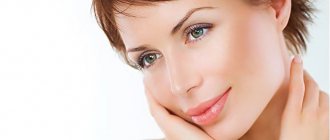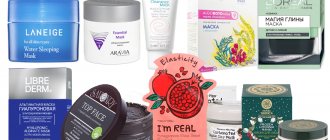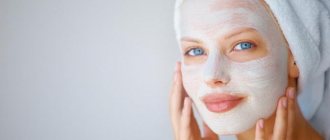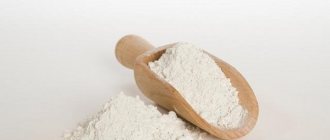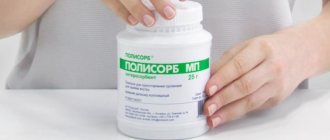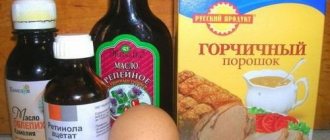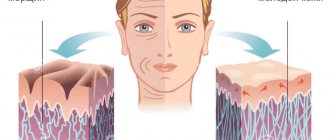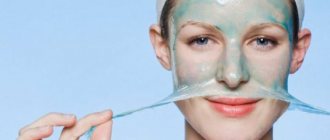Homemade face masks for acne
To use acne masks at home for your face effectively, learn more about them.
There are several types of masks designed for different skin types:
- black;
- from honey;
- with aloe;
- with soda;
- made of clay;
- from aspirin;
- from an egg;
- with cucumber.
Let's consider the options in more detail.
Black mask
Purifying black acne mask is a film mask that draws out impurities from the skin pores. Its viscous structure evens out skin tone, increases its softness, and removes oily shine. Masks can be purchased at cosmetic stores, but it will be cheaper and faster to make them yourself. There are many ways - we’ll tell you how to make the simplest and most effective options.
Option "charcoal and gelatin". You will need several tablets of activated carbon and a tablespoon of gelatin. The recipe is as follows:
- Activated carbon tablets are crushed into powder (use a coffee grinder or spoon).
- Add gelatin and 3-4 tablespoons of water to the resulting mass.
- Stir what you get and heat it in the microwave (8-10 minutes).
- Let the mask cool (about 1 minute) and apply to your face.
- After 20 minutes, the mask will harden - remove it carefully, trying to make it a continuous layer.
Option "coal and egg". The mask is designed to restore a healthy complexion. You will need 2 chicken eggs and 2-3 tablets of activated carbon. Recipe:
- Take the eggs and separate the yolks from the whites.
- Beat the egg whites using a whisk or fork.
- Add pre-crushed activated carbon tablets to the whites
- Mix the resulting mass and apply to the skin. It is better to apply this type of mask not with your palm, but with a brush.
- After 20 minutes, wash off the mask.
If a black mask does not have an astringent component, then we are dealing with a cosmetic mask, and not a film mask.
Coal and water recipe:
- Activated carbon powder (2-3 tablets, crushed with a spoon) is mixed with water/milk.
- The resulting paste is applied to the face.
- The mask is washed off the face after 15–20 minutes.
From honey
A honey acne mask for oily skin will not only heal inflammation on the skin, but also give it elasticity. The lifting elements contained in the main component of the mask - honey - help. They form a film on the surface of the face - it prevents moisture evaporation, while allowing the skin to breathe. The product can be used for any skin type, but it is strongly recommended to avoid its use if you are allergic to honey.
The most effective and natural method of skin restoration is considered to be a mask with honey and oatmeal. You will need 2 tablespoons of cereal and a teaspoon of honey. Recipe:
- Boil the oatmeal (5 minutes, no more) and cool to room temperature.
- The gruel is combined with honey and mixed until smooth.
- The mask is applied to the face, previously cleansed with a scrub. Hardening time: 25 minutes. At the end, the mask is washed off with water at room temperature.
If your skin is flaking, try a mask with cognac - it eliminates irritation. Ingredients: a teaspoon of cognac, a teaspoon of lemon juice, a teaspoon of honey and one egg yolk.
- The honey is heated in a steam bath , and pre-pounded yolk, lemon juice and cognac are added.
- The resulting mass is mixed and applied to the face (holding time is 20 minutes).
- is washed off with a cotton swab dipped in warm water.
With aloe
A mask with aloe refreshes the skin, and the absorbent properties of aloe allow inflammation on the skin to heal faster and more effectively, clearing the face of acne marks. The disadvantages of the mask are the relative labor intensity of its preparation.
To achieve the effect, pre-prepared leaves are used: they are washed in cold water, wrapped in cloth or paper, and placed in a cold place for 2 weeks. If the leaves turn black during the cooking procedure, they cannot be used.
The simplest masks using aloe are plant extracts and fruits. You will need 1-2 aloe leaves, 1 tbsp. a spoonful of fruit pulp (melon, grapes, persimmon, peach, orange - the effect on the skin depends on the acidity of the fruit: more acidic fruit is suitable for oilier skin), 2 teaspoons of vegetable oil.
- Aloe leaf is grated . The resulting slurry is ground with 1 tbsp. spoon of the pulp of your chosen fruit.
- Vegetable oil is added to the mixture The mass is stirred and applied to the face (retention time 20–25 minutes).
- After the expiration date, the mask is removed with water at room temperature.
With soda
Baking soda masks are recommended if your facial skin is oily. Baking soda has an anti-inflammatory and antibacterial effect on irritations, quickly and effectively eliminates redness by removing excess oil and dead skin cells. Baking soda dries out the face and is not recommended for those with sensitive skin.
A mask made from baking soda and salt works effectively. You will need 2 tbsp. spoons of soda and salt.
- Before making the mask, wash your face and apply baby cream.
- Mix salt and baking soda and rub the mixture into the skin with gentle rubbing movements.
- the mixture for 15 minutes, then rinse with cool water.
It’s important to use fine salt. If you want to use sea salt, grind it (use a coffee grinder).
The second method is for delicate skin. You will need 1 egg white and 1 teaspoon of baking soda.
- Raw protein is mixed with soda.
- The mass is applied to the face in a thin layer and held on the skin for about 20 minutes until it hardens.
- After the period has passed, it is carefully washed off the face, after which the skin is treated with chamomile decoction.
From clay
The clay treatment method is one of the oldest ways to improve skin. Clay treats not only inflammation, but also psoriasis, dermatitis and eczema. The substance is a natural antiseptic, whitens the skin, dries it and smoothes out wrinkles. Clay is hypoallergenic and can be used for any skin type.
Recipes for use vary.
The first option - you will need 1 teaspoon of water, 1 teaspoon of fresh cucumber, 2 tablespoons of clay and a little olive oil.
- Add cucumber juice and use this liquid to dilute the clay.
- Add olive oil and lemon juice to the mixture
- Apply the mixture to the skin and wait for it to dry (20 minutes).
- When the mask hardens, wash it off with water .
To nourish the skin, make a mask with grapes. You will need 2 tablespoons of white clay, 1 teaspoon of grape juice and 1 teaspoon of honey.
- Mix clay, grape juice and honey into a paste.
- Apply the paste and wait for it to harden (20 minutes)
- After hardening, wash off the mask with water.
From aspirin
A mask for acne on the face made from aspirin is considered the fastest-acting - the effect will be visible the very next day. The mask helps to get rid of not only acne, but also its consequences - uneven skin. Here you will need 4 aspirin tablets and 2 teaspoons of honey.
- The tablets are ground into powder, a little water is added to them (no more than 4-5 drops).
- The resulting mass is ground with honey and applied to the face for 10 minutes.
- After 10 minutes, the mask is washed off with water.
From an egg
Egg is used as an ingredient in many mask recipes, but it can also be used separately.
- to make a mask from an egg, you need to beat it with a mixer;
- Apply the resulting foam onto your face using even movements;
- wait 15–20 minutes and rinse off the mask with water at room temperature.
This mask is an effective solution for teenage rashes and acne.
Cucumber based
Such masks are considered classic - cucumber can refresh the face, moisturize it and relieve irritation. We invite you to try a gentle yogurt mask; it will cleanse your face and relax you after a long day. Prepare one cucumber and half a glass of low-fat yogurt.
- Wash the cucumber and mash it with a mortar or spoon.
- Add yogurt to the cucumber and stir (there should be no lumps).
- Apply the mixture to your face and wait 15–20 minutes, then rinse with water.
Useful masks for teenage skin with chamomile
Chamomile is a well-known medicinal plant that is used to treat internal organs and skin ailments. Masks with chamomile are successfully used in the treatment of pimples and acne.
Recipes for masks with chamomile:
- Brew a strong chamomile decoction. Peel the aloe and chop the pulp. Pour a spoonful of chamomile infusion into the puree and add a spoonful of mashed potatoes. Spread the thick mixture evenly on your face. Exposure time 15 minutes
- Prepare a mixture of baking soda and fine salt. The ingredients are mixed in a 1:1 ratio. Take a piece of baby soap, moisten a washcloth with chamomile infusion and rub it on the soap. Add the resulting foam to the dry mass until you get a paste. Apply to skin for 3-10 minutes. If it burns too much, wash off the composition immediately.
- Mix honey, wheat flour and chamomile decoction in equal quantities. Apply the resulting batter onto your face using a brush. Keep it for a third of an hour
Stories of teenagers: what helped whom?
Which acne masks to choose at home for teenagers? Please note that inflammations are the result of poor nutrition, stress and natural stages of development of a boy or girl, therefore the use of funds should be discussed with the attending physician.
One of the most effective and harmless methods for removing acne in teenagers is tar soap. They not only wash with it regularly, but also apply it as a mask on the face for 5–7 minutes, after which they wash off with warm water. Here are some reviews:
My daughter has entered a difficult age (14 years old) – restructuring of the body’s internal system, hormones. We thought for a long time about how to get rid of the problem and agreed to try making a mask from aloe juice. As it turned out, it is easy to do, and the effect is excellent. As a result, the pimples first dried out and then disappeared.
At the age of 15, I had a problem - my skin became excessively oily. When I started to fight it, peeling appeared and the skin lost its color. A mask of honey and lemon juice helped. At first there was no noticeable effect, but at the end of the course some of the pores cleared up. Mostly I made masks at night.
Features of application
Face masks for teenagers will be most beneficial if used correctly at home:
- Any mask must be tested (description above).
- It is recommended to perform the procedure twice - three times a week.
- Apply only to skin that has been steamed using a hot or steam bath.
- Before the procedure, you can use a gentle cleansing scrub.
- The mask must be prepared strictly according to the chosen recipe; it is not recommended to change the dosage or mix the compositions of different masks with each other.
- The procedure time is no more than 15 - 20 minutes.
- The components included in the composition must be natural and fresh. It is better to use homemade eggs and dairy products, and fruits, vegetables, and herbs grown without the use of chemicals.
- It is best to wash off the mixture with water at room temperature or cool.
How long does it take to get rid of acne
Acne is a disease that occurs in each person with varying intensity and is not always resolved in 1 day. A mild degree of the disease does not require drug treatment; acne gets rid of acne in 6–10 weeks.
If the dermatologist's recommendations have not been followed, then the problem increases. Inflammations can be treated for up to a year, but their consequences last longer. The speed of your recovery will depend on how quickly you start treatment. Hygiene and dietary restrictions are mandatory.
How to supplement external treatment
Juvenile acne affects 80% of teenagers. They arise due to hormonal changes in the body that affect the functioning of the sebaceous glands. When follicles are clogged with sebum, conditions arise for the proliferation of bacteria that cause purulent inflammation. To cope with the problem, external therapy is supplemented with oral medications:
- antibiotics (Limecycline, Erythromycin, Josamycin) – destroy pathogenic bacteria in the skin, relieving inflammation;
- retinoids (Acnecutane, Isotretinoin, Roaccutane) – restore skin regeneration processes, suppress sebum secretion, relieve inflammation and prevent the formation of acne;
- antiandrogens (Cyproterone, Progestin, Flutamide) - reduce the content of male hormones that provoke acne.
If anti-acne masks and other local remedies are ineffective, hormonal drugs are used. They suppress inflammation, improving the condition of teenage skin. But you should use pharmaceutical products to treat acne only on the recommendation of a dermatologist. Overuse of medications can lead to decreased immunity and even greater skin inflammation.
What other effective medications for acne are there that can be used at home?
Not only masks, but also tinctures help against acne. They wipe problem areas of the skin. The most effective is chamomile tincture. You will need 1 teaspoon of dried chamomile.
- pour a glass of boiling water;
- leave for 30 minutes;
- strain.
Potato juice helps with abscesses on the face. It is mixed with aloe juice in a 2:1 ratio and wiped over the face in the morning.
Conclusion
Teenage skin needs special attention. High-quality daily facial cleansing in the morning and evening comes to the fore. At the same time, it is necessary to have your face cleaned by a cosmetologist on an ongoing basis approximately once a month. In particularly advanced cases, the procedure may be prescribed more often. Metabolic processes in the body of a teenager occur much faster than in an adult, so you need to constantly monitor the condition of your skin. The less often professional cleaning is carried out, the larger the comedones become, the longer and more painful the procedure is, and accordingly, rehabilitation will also take more time.
Tips for caring for oily skin
If your skin is too oily, we recommend that you take more care of it. The tips below will help:
- Don't overeat junk food. Fast food and fried foods cause skin problems. Acne often appears due to problems with the functioning of the stomach.
- Don't work on the computer too much. Monitors dry out the skin, irritate it and cause flaking.
- Choose your cosmetics wisely . If creams are not suitable for your skin type, then problems and rashes begin.
- Wash off your makeup. You shouldn't go to bed with makeup on - your skin should rest.
All unsuccessful? It's time to see a doctor!
It happens that with proper care, diet and lifestyle, acne does not even think of disappearing. This may indicate that the problem lies deeper. In this case, your doctor will help you understand the causes of acne. Only a specialist will find out what causes acne: mites, skin diseases, disruptions in the endocrine system and hormonal levels. Once the cause is identified, effective treatment can begin.
A dermatologist is the first doctor you should contact. He will identify existing skin problems and diseases, select care and treatment procedures.
Gastroenterologist - solves problems in the digestive tract, the presence of which can provoke the occurrence of acne.
Endocrinologist – hormonal imbalance is one of the most common causes of acne in adolescence. The doctor will determine which hormones are elevated and offer a solution.
Gynecologist – it makes sense for girls to visit a gynecologist, since acne can be a consequence of gynecological diseases, such as polycystic ovary syndrome.
Type of acne
Acne appears on the face in different ways, treatment depends entirely on its type:
- Closed - clogged pores, have a whitish, convex appearance, remain on the skin for quite a long time. Inflammation does not occur; they appear and disappear on their own. More often they appear in the forehead and chin area.
- Open – these include blackheads. As a rule, the pores are enlarged, dirt and fat penetrate there and settle, for this reason the pimple has a dark color.
- Papules are an inflamed area with red raised areas. There is no pus inside. They can dry out in a few days, or they can turn into a pustule.
- Pustules are inflamed areas that have a cavity inside that is filled with pus. They are soft and painful to the touch. May leave scars.
- The nodes are hard to the touch, inflamed, painful. There is no pus inside. They last quite a long time, gradually dissolve and decrease in size.
- Cysts are a combination of several pustules into one whole, they have several abscesses, the color changes from red to bluish. New pimples can form inside them, so they take a long time to disappear. Quite often, scars remain in their place.
